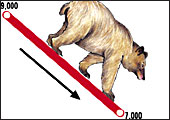|
It
took all of $4.3 billion (Rs 19,350 crore) of inflows from foreign
institutional investors (FIIs) to propel the benchmark Sensex
from 7,000 to 8,000 points. On November 28, when the 30-share
BSE index shot into the stratosphere of 9,000, it took just $796.20
million (Rs 3,583 crore approx.) of FII greenbacks to boost it
into that region from the October 28 closing of 7,656. Don't delude
yourself into believing that perhaps the liquidity created by
domestic mutual funds and the good old retail Joe contributed
their mite to the Sensex surge. The simple truth is that when
the index touched 9,000-for the first time in 131 years of trading
on the BSE-the spurt came on the back of low volumes-9 per cent
lower than in October. That's enough reason for concern in pockets
of Dalal Street. As Andrew Holland, Chief Administrative Officer
& Executive Vice President (Research), DSP Merrill Lynch,
points out: "The mood is extremely cautious as the market
from these levels looks overvalued. The lower volumes and lower
FII net investments have also contributed to that mood."
Then again, you have the bulls, one of them
being Gurunath Mudlapur, Managing Director, Atherstone Institute
of Research. Mudlapur is convinced about the long-term opportunity
that exists on the Indian markets, courtesy strong economic growth
and attractive relative valuations. He's hopeful that good GDP
numbers, boosted in no small measure by an impressive Rabi crop,
will boost rural spending. Mudlapur expects the Sensex to hit
11,500 in the next six to 12 months. "My optimism is based
purely on the India growth story and the impressive second quarter
GDP growth of 8 per cent (6.7 per cent in the previous year's
corresponding period), which was driven by strong growth in manufacturing
and services."
BULLISH SCENARIO
Sensex pole-vaults into 12,000
territory |
 LIKELIHOOD:
40-50 per cent in the next six to 12 months LIKELIHOOD:
40-50 per cent in the next six to 12 months
EARNINGS GROWTH PROJECTION: 20 per cent for the
next four quarters
P-E AT THESE LEVELS: 18-19
REFORMS FROM GOVERNMENT: Many
GDP GROWTH PROJECTION FOR 2005-06: 8-8.5 per cent
OTHER JUSTIFICATIONS: Government embarks on second
wave of reforms, like allowing FDI (foreign direct investment)
in retail space or further opening up the power sector or
the introduction of pension reforms; flows from local funds
and retail investors gather momentum; investments in infrastructure
register a significant increase; rural spending rises on
the back of a good Rabi crop and higher industrial activity
|
STATUS QUO SCENARIO
Sensex hovers around 9,000 territory |
 LIKELIHOOD:
15-30 per cent LIKELIHOOD:
15-30 per cent
EARNINGS GROWTH PROJECTION: 15-20 per cent
P-E AT THESE LEVELS: 15
REFORMS FROM GOVERNMENT: Few
GDP GROWTH PROJECTION FOR 2005-06: 7-8 per cent
OTHER JUSTIFICATIONS: Corporate earnings growth,
though not disappointing, is in line with market expectations,
of 15-20 per cent; FII inflows are targeted more towards
the mid caps than the large caps, resulting in modest liquidity
conditions; the markets will continue to be rangebound,
as upward moves aren't backed by strong volumes and robust
inflows from foreign institutional investors (FIIs)
|
BEARISH SCENARIO
Sensex slips back into 7,000-7,500
territory |
 LIKELIHOOD:
10-30 per cent LIKELIHOOD:
10-30 per cent
EARNINGS GROWTH PROJECTION: Lower than 15 per cent
in the next two to three quarters
P-E AT THESE LEVELS: 12-13
REFORMS FROM GOVERNMENT: Negligible
GDP GROWTH PROJECTION FOR 2005-06: 6-6.5 per cent
OTHER JUSTIFICATIONS: FII flows dry up, global
crude prices touch $70 (Rs 3,150) per barrel in the January-March
period, rupee weakens on account of a strengthening dollar,
India's current account deficit, already 2.5 per cent of
GDP, continues to rise, corporate performance slows down
to under 15 per cent earnings growth, lack of reforms ahead
of elections in West Bengal and Kerala
|
So, is the Sensex set to break out of the
8,900-9,000 range, and shoot into further uncharted territory?
Or can it slide back to the 7,000-7,500 levels? One area of concern
is the seemingly overvalued nature of the Indian markets, what
with the Sensex quoting at a price-earnings (p-e) multiple of
18, based on 2005-06 earnings. This makes India one of the more
expensive markets in the world, more dear than Russia, Brazil,
Korea, Pakistan and Sri Lanka. Yet, the bulls out there are counting
on solid future earnings growth, which will effectively rein in
on the high p-e levels at higher index levels. Amit Rathi, Managing
Director, Anand Rathi Securities, actually feels that the Indian
market looks cheap if you consider the earnings growth that's
yet to come. At the current index levels, his brokerage has projected
a p-e of 14.4 times on March 2006 earnings and 12.56 times on
March 2007 earnings.
 |
| The bulls are riding on their conviction
of the long-term India story, courtesy strong growth and attractive
valuations |
Still, you have to be an unabashed optimist
to be able to confidently predict profits of Indian corporates
for the next six quarters. The current trend isn't very encouraging,
pointing to signs of a slowdown. For the quarter ended September
2005, net profits grew by 13 per cent compared to 29 per cent
in the corresponding period of the previous year. Sales growth
also stuttered, from 21 per cent last September to just 8.3 per
cent. What's more, for the second quarter of 2005-06, earnings
growth of the Sensex was 23 per cent on a year-on-year basis,
which is lower than the 31 per cent growth reported in the first
quarter. "Markets aren't cheap at current levels," grimaces
S. Naren, Co-head (Equities), Prudential ICICI AMC, who feels
there could be disappointment on the corporate performance front,
as the market has already discounted 2007 earnings.
With the Indian markets still largely driven
by FII liquidity, plenty depends on which direction the inflows
are headed. Says Naresh Kothari, Head (Institutional Equities),
Edelweiss Securities: "Liquidity will be the biggest factor
in dictating the trend in the market. If liquidity stops, the
valuations will get lined to their fundamentals. There are possibilities
of the Sensex coming down to the 7,000-7,500 levels." Holland
feels that with the Sensex p-e trading above 17 times and the
us interest rates expected to rise to 5 per cent, FII inflows
can only slow down. Pressure on liquidity could also arise in
the wake of rising commodity prices, especially global crude oil,
currency depreciation, rising deficit of the government, liquidity
pressure in the economy and delay in implementation of infrastructure
projects.
The current account deficit, which is about
2.5 per cent of the total GDP, is one sure-fire worry. If one
looks at the Indian trade deficit numbers, there is an average
deficit of $3 billion (Rs 13,500 crore) per month. So far, this
gap has been made up by FII inflows. The day the deficit is no
longer matched by corresponding capital flows, it will impact
the rupee exchange rate. The high trade deficit continued to weigh
on the rupee, which weakened by 1.7 per cent in the last one month.
If Ajay Mahajan, President (Financial Markets
& Institutions), yes Bank, is upbeat that the rally will continue,
it's for all the usual reasons (strong fundamentals, outsourcing
story, second wave of reforms et al). Plus he's also banking on
increased participation from the retail investor. Clearly, the
indices are surging upwards on the back of strong FII flows, but
if the bull market has to be sustained over the longer term, more
and more retail investors will have to become disciples of the
equity cult.
|




 LIKELIHOOD:
40-50 per cent in the next six to 12 months
LIKELIHOOD:
40-50 per cent in the next six to 12 months
 LIKELIHOOD:
15-30 per cent
LIKELIHOOD:
15-30 per cent
 LIKELIHOOD:
10-30 per cent
LIKELIHOOD:
10-30 per cent
